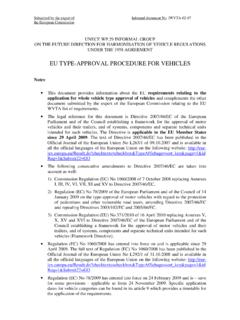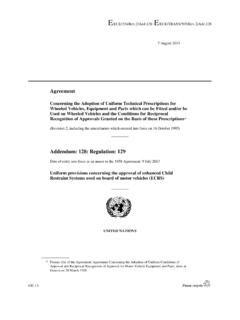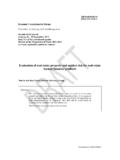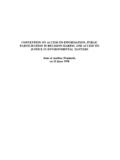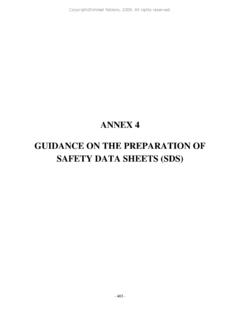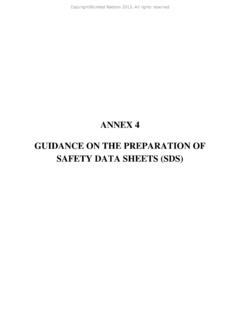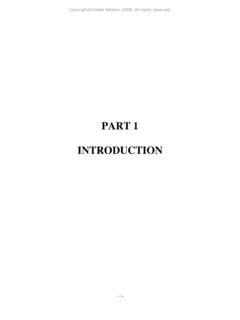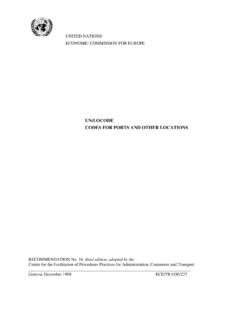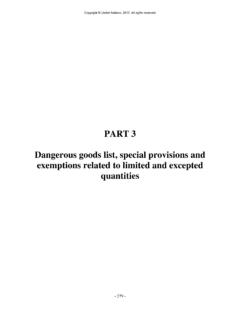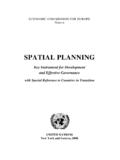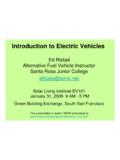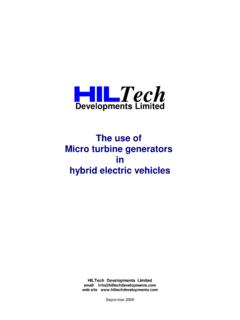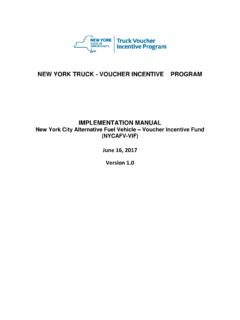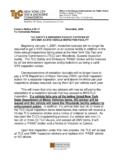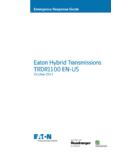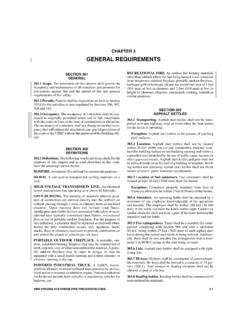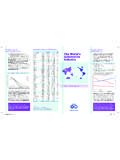Transcription of ECE
1 Global Registry Created on 18 November 2004, pursuant to Article 6 of the Agreement concerning the establishing of global technical regulations for wheeled vehicles, equipment and parts which can be fitted and/or be used on wheeled vehicles (ECE/TRANS/132 and ) done at Geneva on 25 June 1998 Addendum 15: Global technical regulation No. 15 Worldwide harmonized Light vehicles Test Procedure Established in the Global Registry on 12 March 2014 UNITED NATIONS ECE/TRANS/180 12 May 2014 ECE/TRANS/180 3 Global technical regulation on Worldwide harmonized Light vehicles Test Procedure Contents Page I.
2 Statement of technical rationale and 5 A. Introduction .. 5 B. Procedural background and future development of the WLTP .. 6 C. Background on driving cycles and test procedures .. 7 D. Technical feasibility, anticipated costs and benefits .. 8 II. Text of the global technical regulation .. 10 1. Purpose .. 10 2. Scope and application .. 10 3. Definitions .. 10 4. Abbreviations .. 16 5. General requirements .. 18 6. Performance requirements .. 20 Annexes 1 Worldwide light-duty test cycles (WLTC).
3 22 2 Gear selection and shift point determination for vehicles equipped with manual transmissions .. 72 3 Reference fuels .. 76 4 Road load and dynamometer setting .. 91 Appendix 1 - Calculation of road load for the dynamometer test .. 117 Appendix 2 - Adjustment of chassis dynamometer load setting .. 119 5 Test equipment and calibrations .. 121 6 Type 1 test procedure and test conditions .. 165 Appendix 1 - Emissions test procedure for all vehicles equipped with periodically regenerating systems .. 180 Appendix 2 - Test procedure for electric power supply system 185 7 Calculations.
4 190 8 Pure and hybrid electric vehicles .. 205 Appendix 1a - RCB profile OVC-HEV, charge-depleting and charge-sustaining tests .. 223 Appendix 1b - RCB profile, OVC-HEV and NOVC-HEV charge-sustaining test .. 224 Appendix 1c - RCB profile, PEV, electric range and electric energy consumption test .. 225 Appendix 2 - REESS charge balance (RCB) correction .. 226 ECE/TRANS/180 4 Appendix 3 - Measuring the electricity balance of NOVC-HEV and OVC-HEV batteries .. 229 Appendix 4 - Preconditioning of PEVs and OVC-HEVs .. 230 Appendix 5 - Utility factor (UF) for OVC-HEVs.
5 232 [Appendix 6 - RESERVED: Determining the range of PEVs on a per-phase basis] .. 233 [9 RESERVED: Determination of system equivalence] .. 234 ECE/TRANS/180 5 I. Statement of technical rationale and justification A. Introduction 1. The compliance with emission standards is a central issue of vehicle certification worldwide. Emissions comprise criteria pollutants having a direct (mainly local) negative impact on health and environment, as well as pollutants having a negative environmental impact on a global scale.
6 Regulatory emission standards typically are complex documents, describing measurement procedures under a variety of well-defined conditions, setting limit values for emissions, but also defining other elements such as the durability and on-board monitoring of emission control devices. 2. Most manufacturers produce vehicles for a global clientele or at least for several regions. Albeit vehicles are not identical worldwide since vehicle types and models tend to cater to local tastes and living conditions, the compliance with different emission standards in each region creates high burdens from an administrative and vehicle design point of view.
7 vehicle manufacturers, therefore, have a strong interest in harmonizing vehicle emission test procedures and performance requirements as much as possible on a global scale. Regulators also have an interest in global harmonization since it offers more efficient development and adaptation to technical progress, potential collaboration at market surveillance and facilitates the exchange of information between authorities. 3. As a consequence stakeholders launched the work for this global technical regulation (gtr) on Worldwide harmonized Light vehicle Test Procedures (WLTP) that aims at harmonizing emission related test procedures for light duty vehicles to the extent this is possible.
8 vehicle test procedures need to represent real driving conditions as much as possible to make the performance of vehicles at certification and in real life comparable. Unfortunately, this aspect puts some limitations on the level of harmonization to be achieved, since for instance, ambient temperatures vary widely on a global scale. In addition, due to the different levels of development, different population densities and the costs associated with emission control technology, the regulatory stringency of legislation is expected to be different from region to region for the foreseeable future.
9 The setting of emission limit values, therefore, is not part of this gtr for the time being. 4. The purpose of a gtr is its implementation into regional legislation by as many Contracting Parties as possible. However, the scope of regional legislations in terms of vehicle categories concerned depends on regional conditions and cannot be predicted for the time being. On the other hand, according to the rules of the 1998 UNECE agreement, Contracting Parties implementing a gtr must include all equipment falling into the formal gtr scope.
10 Care must be taken, so that an unduly large formal scope of the gtr does not prevent its regional implementation. Therefore the formal scope of this gtr is kept to the core of light duty vehicles. However, this limitation of the formal gtr scope does not indicate that it could not be applied to a larger group of vehicle categories by regional legislation. In fact, Contracting Parties are encouraged to extend the scope of regional implementations of this gtr if this is technically, economically and administratively appropriate.
